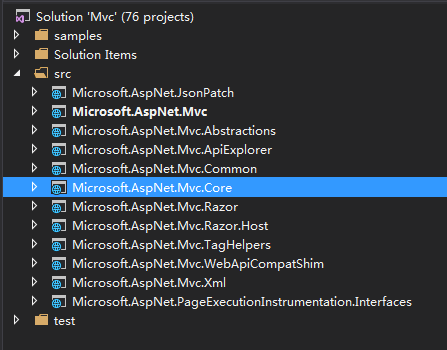ASP.NET MVC 源码分析(一)
直接上图:

我们先来看Core的设计:

从项目结构来看,asp.net.mvc.core有以下目录:
ActionConstraints:action限制相关
AntiForgery:防伪相关
ActionResults:action返回对象相关
ApiExplorer:API描述和元数据相关接口
ApplicationModels:应用程序模型相关,应该是全局的model
Areas:地区标签
Filters:大名鼎鼎的过滤器组件
Formatters:格式化相关的东东
Internal:这个从名称看不出是做什么的,打开一看里面是一个路由决策树的实现
ModelBinding:模型绑定,从request 对象取值映射到model的实现
ParameterBinding: ModelBinding的上下文和模型更新入口
Rendering:重量级选手,视图渲染逻辑都在这了
Routing:路由控制相关
ViewComponents:视图组件
剩下的一些零闪的类大致就是controller,controllerFactoary和一些限定请求资源的标签的实现,OK 接下来让我们开始探究吧!
面对一堆的类我们要从哪开始入手呢?对!我们要找到整个core的生命周期的主线,从主线入手解析相关组件设计,根据ASP.NET整个管道模型的设计(园子讲这个的文章很多,我就不熬述了),我们可以了解到,asp.net.mvc.core 实际上负责的是httphandler生命周期中做的一些事情,他从获取httpContext.Request 对象进行消息路由(Routing),请求过滤(filters,AntiForgery,ActionConstraints),参数映射(比如modelBinding,ParameterBinding),参数验证(比如modelValidate),逻辑处理,最后返回结果(ActionResults),对结果进行渲染输出到流(Rendering,ViewComponents)。
我们从Microsoft.AspNet.Routing开始看:
最高层的抽象IRouter,这个路由接口到底做了什么事情呢?
public interface IRouter { Task RouteAsync(RouteContext context); VirtualPathData GetVirtualPath(VirtualPathContext context); }
这个接口只有两个方法,一个是RouteAsync根据路由上下文解析路由到相应的处理器上,一个GetVirtualPath负责生成路由的URL,即URL重写asp.net 5为了平台的可移植性,把大部分组件都和system.web 解耦了,以前的版本route的抽象是超类RouteBase负责,包命为System.Web.Routing,废话不多说,上代码:
public abstract class RouteBase { private bool _routeExistingFiles = true; /// <summary> /// Gets or sets a value that indicates whether ASP.NET routing should handle URLs that match an existing file. /// </summary> /// /// <returns> /// true if ASP.NET routing handles all requests, even those that match an existing file; otherwise, false. The default value is false. /// </returns> public bool RouteExistingFiles { get { return this._routeExistingFiles; } set { this._routeExistingFiles = value; } } /// <summary> /// When overridden in a derived class, returns route information about the request. /// </summary> /// /// <returns> /// An object that contains the values from the route definition if the route matches the current request, or null if the route does not match the request. /// </returns> /// <param name="httpContext">An object that encapsulates information about the HTTP request.</param> public abstract RouteData GetRouteData(HttpContextBase httpContext); /// <summary> /// When overridden in a derived class, checks whether the route matches the specified values, and if so, generates a URL and retrieves information about the route. /// </summary> /// /// <returns> /// An object that contains the generated URL and information about the route, or null if the route does not match <paramref name="values"/>. /// </returns> /// <param name="requestContext">An object that encapsulates information about the requested route.</param><param name="values">An object that contains the parameters for a route.</param> public abstract VirtualPathData GetVirtualPath(RequestContext requestContext, RouteValueDictionary values); }
从以上两段代码的区别我们可以看到,移植后的GetRouteData改成了异步的RouteAsync返回了一个task,两个方法的输入参数都构造了自己的上下文环境对象,不在直接从httpContext中操作。啰嗦一句,在.net中我们随处可以见这种基于context上下文的设计,这种基于上下文的设计有什么好处呢,分离关注点,管理环境对象的生命周期灰常的nice.
打开RouteContext看一下这家伙到底做了些什么:
namespace Microsoft.AspNet.Routing { public class RouteContext { private RouteData _routeData; public RouteContext(HttpContext httpContext) { HttpContext = httpContext; RouteData = new RouteData(); } public HttpContext HttpContext { get; private set; } public bool IsHandled { get; set; } public RouteData RouteData { get { return _routeData; } [param: NotNull] set { _routeData = value; } } } }
打开一看,尼玛,原来就是httpContext,routeData,IsHandled的一个组合,哈哈,在.net的设计中组合优于继承的思想基本烂大街,httpContext 就不说了,asp.net 生命周期的管控全靠它,isHand一个bool值的属性(我猜估计是指示路由是否完成之类的标识),routeData这个才是route组件独有的东东,看这个名字我们就知道他是一个数据结构,保存的是路由相关的信息:
/// <summary> /// Creates a new <see cref="RouteData"/> instance with values copied from <paramref name="other"/>. /// </summary> /// <param name="other">The other <see cref="RouteData"/> instance to copy.</param> public RouteData([NotNull] RouteData other) { DataTokens = new Dictionary<string, object>(other.DataTokens, StringComparer.OrdinalIgnoreCase); Routers = new List<IRouter>(other.Routers); Values = new RouteValueDictionary(other.Values); }
([NotNull] 这个标签是最新的语法特性,同样体现的是一种声明式编程的思想)我们通过这个构造函数可以知道我们创建routeData的时候需要传入一些可能是路由规则配置的dictionary信息,具体他是怎么工作的,到时候看调用的时候就真相大白了。
让我们回过头来看VirtualPathContext,由于重写呈现给客户端查看的URL地址肯定是发生在GetRouteData路由之后的,我们可以大胆的猜想他也是持有HttpContext对象和另一些route相关数据对象的组合,果不其然,他的实现没有让我们失望:
public class VirtualPathContext { public VirtualPathContext(HttpContext httpContext, IDictionary<string, object> ambientValues, IDictionary<string, object> values) : this(httpContext, ambientValues, values, null) { } public VirtualPathContext(HttpContext context, IDictionary<string, object> ambientValues, IDictionary<string, object> values, string routeName) { Context = context; AmbientValues = ambientValues; Values = values; RouteName = routeName; } public string RouteName { get; private set; } public IDictionary<string, object> ProvidedValues { get; set; } public IDictionary<string, object> AmbientValues { get; private set; } public HttpContext Context { get; private set; } public bool IsBound { get; set; } public IDictionary<string, object> Values { get; private set; } }
OK,IRouter的介绍到此为止。
下一篇我们将开始介绍IRouteBuilder路由构建者接口,也是route组件的核心。